
Tin CD/DVD Case Round D-Shape w/ Window Clear Tray JCT20120

Tin CD/DVD Case Round D-Shape no Window Clear Tray JCT20020

Tin CD/DVD Case Round Shape no Hinge with Window JCT21110

Tin CD/DVD Case Round D-Shape w/ Window Blue Tray JCT20100
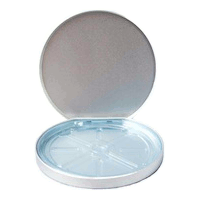
Tin CD/DVD Case Round D-Shape no Window Blue Tray JCT20000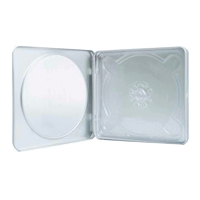
Tin CD/DVD Case Square Style w/ Window Clear Tray JCT10120
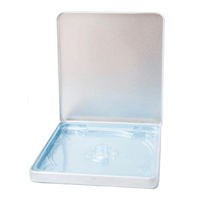
Tin CD/DVD Case Square Style no Window Blue Tray JCT10000

Tin CD/DVD Case Square Style no Hinge no Window JCT11010
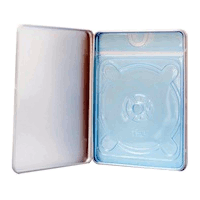
Tin DVD/CD Case Rectangular no Window Blue Tray DCT30000
Tin DVD/CD Case Rectangular with Window Blue Tray DCT30100
NIST/Library of Congress (LC)
Optical Disc Longevity Study.
The LIBRARY of CONGRESS
NIST/LC: OPTICAL DISC LONGEVITY STUDY
The Library of Congress and the National Institute of Standards and Technology do not recommend or endorse commercial products or enterprises, and makes no claims about the stability of any particular brand or type of media; therefore, no brand names are included in this report. The CD and DVD media used for this study were acquired in 2005. Test results and longevity estimations for the products used in this research may not reflect the quality of currently manufactured media. This report is published for information and research purposes only.
Certain commercial entities, equipment, or materials may be identified in this document in order to describe an experimental procedure or concept adequately. Such identification is not intended to imply recommendation or endorsement by the Library of Congress or the National Institute of Standards and Technology, nor is it intended to imply that the entities, materials, or equipment are necessarily the best available for the purpose.
September 2007
Preface
1 Introduction
2 Technical Background and Eyring Model
3 Definitions
4 Procedure
4.1 Procedural Overview
4.2 Test Method
4.3 Test Conditions
4.4 Test Discs
4.4.1 CD-R discs
4.4.2 Recordable and Rewritable DVD discs
4.5 Analysis of the discs
4.6 Measurement and Collecting data
4.6.1 Media recording and initial data
4.6.2 Media burning stations
4.6.3 Analyzer
4.6.4 Collecting data
4.7 Requirements of incubation condition
4.7.1 Environmental chambers
4.8 Incubation time requirements
4.9 Step by step summary analysis of data
5 Results
6 Conclusion
7 Normative references
8 Bibliography
Appendix I – Example result and analysis
Appendix II – Disc coding system for LE test
Preface
The Information Access Division (IAD) of the Information Technology Laboratory (ITL) at the
National Institute of Standards and Technology (NIST), in collaboration with the Preservation
Research and Testing Division (PRTD) at the Library Of Congress (LC) established a
collaboration to test the longevity of recordable optical media including DVD-R, DVD+R, DVD-
RW, DVD+RW, and CD-R. The details of this collaboration, results, and analysis are presented
in this report.
About the Library of Congress
The Library of Congress is the nation's oldest federal cultural institution and serves as the
research arm of Congress. It is also the largest library in the world, with more than 130 million
items on approximately 530 miles of bookshelves. The collections include more than 29 million
books and other printed materials, 2.7 million recordings, 12 million photographs, 4.8 million
maps, and 58 million manuscripts.
Preservation Research and Testing Division of the Library of Congress conducts scientific research to advance the preservation of the Library’s collections by extending their useful life as long as possible. Besides traditional book and manuscript materials, these collections include a variety of other media, including photographs, motion picture film, magnetic tape, and digital optical media such as CDs and DVDs. This division is also responsible for establishing specifications, acceptable practices, and testing protocols for all materials used for the conservation and/or storage of the Library’s permanent collections, as well as for specifying acceptable storage conditions, conservation practices and treatment processes that may have a direct or indirect impact on the longevity of the collections.
About NIST
Founded in 1901, NIST is a non-regulatory federal agency within the U.S. Commerce
Department's Technology Administration. NIST's mission is to develop and promote
measurement, standards, and technology to enhance productivity, facilitate trade, and improve
the quality of life. NIST carries out its mission in four cooperative programs, the NIST
Laboratories, conducting research that advances the nation's technology infrastructure and is
needed by U.S. industry to continually improve products and services, the Baldrige National
Quality Program, the Manufacturing Extension Partnership, and the Advanced Technology
Program.
NIST has an operating budget of about $858 million and operates in two locations: Gaithersburg, Md., (headquarters—234-hectare/578-acre campus) and Boulder, Colo., (84-hectare/208-acre campus). NIST employs about 3,000 scientists, engineers, technicians, and support and administrative personnel. About 1,800 NIST associates complement the staff. In addition, NIST partners with 1,400 manufacturing specialists and staff at affiliated centers around the country.
The NIST/LoC Project Team:
J. Zheng (NIST contractor, Lead Scientist),
O. Slattery, F. Byers, A. Klepchukov, Anna Nhan (NIST),
C. Shahani, M. Youket, E. Eusman, N. Olson (LC).
1. Introduction
The preservation of digital information has become a critical issue for many organizations, not
least the libraries and archives of the US Government. According to the National Digital
Information Infrastructure and Preservation Program (NDIIPP), which is administered by the
LC, information is being produced in greater quantities and with greater frequency than at any
time in history. Furthermore, according to the NDIIPP, electronic media, especially the Internet,
make it possible for almost anyone to become a "publisher." The program asks: How will society
preserve this information and make it available to future generations?
Optical media has become the medium of choice for digital storage in many government agencies as well as many organizations within the private sector. In 2004, the Information Access Division of the National Institute of Standards and Technology (NIST) and the Preservation Directorate at the Library of Congress (LC) agreed to perform an investigation of the longevity of recordable Compact Disc (CD) and Digital Versatile Disc (DVD) media. This report outlines the procedural details of that investigation for estimating the life expectancy of information stored in CD-R, DVD-R and DVD+R, as well as DVD-RW and DVD+RW discs. The test procedure uses accelerated aging techniques and statistical analysis to estimate the standardized life expectancy (LE) of recordable DVD and CD media purchased in 2005.
Only the effects of temperature and relative humidity on the media are considered. The standardized life expectancy estimated using this model is defined for discs maintained at 25 ºC and 50 % RH, but can be applied to give an estimate of the life expectancy at any moderate storage condition. Discs exposed to more severe conditions of temperature and humidity are expected to experience a shorter life. The test plan does not attempt to model degradation due to exposure to light, corrosive gases, contaminants, or mishandling, nor does it account for variations in the playback subsystem. Furthermore, the compatibility of the recorder and the media will have a critical effect on the LE of media, including very stable media since error rates immediately after recording will impact the length of time before failure. For this study, great care was taken to ensure compatibility between the recorder and the media, thus ensuring low initial error rates.
In this report, all identifying information about the products has been removed. This study was not intended as a consumer report nor as a way to determine the longevity of particular brands but to help the LC get a meaningful sense of the longevity of optical media in general. This report summarizes the study and its results. It is important that NIST and the LC are not seen to be endorsing some products by including specific products in the study. It is also important for the industry to be confident that identifying information will not be disclosed so as to ensure their continued support and cooperation with optical media studies at NIST and the LC. It is the policy of NIST and the Library of Congress not to endorse any particular products.
2. Technical Background and Eyring Model
Recordable optical disc media contain an organic dye layer in which the transparency can be
altered either to absorb the energy from a laser beam or to allow the beam to pass through to a
reflective layer behind the dye [1, 2, 3]. The nature of this organic dye is such that when the
internal energies of its molecules reach a particular threshold, an irreversible chemical reaction
occurs, and the dye layer loses its transparency. This allows a high-energy beam to ‘write’ data
by burning ‘pits’, in the form of dark marks, to the disc during recording. A low powered laser
reads the data by either passing through the transparent dye layer (without causing any molecular
change) to the reflective layer or by being absorbed by the nontransparent marks in the dye.
Due to the organic nature of the dye, degradation and breakdown of the transparent portion of dye layer will occur over a long period of time as a natural process. This process, which has its roots in chemical kinetics, can take several years in normal environmental conditions [4]. Higher temperatures and humidity will accelerate this process by increasing the thermal and kinetic energies of the dye molecules.
The effect of these processes can be modeled using various techniques including the Eyring model, which has a theoretical basis in chemistry and quantum mechanics and can be used to model acceleration when many stresses are involved. For this study, the Eyring equation will be used to model the effect of two stresses, temperature and relative humidity, on the rate of a reaction or degradation, which can be related to the time-to-failure of the optical disc.
The Eyring model has found broad application and is the current model for estimating life expectancies of Recordable CD/DVD systems. The equation
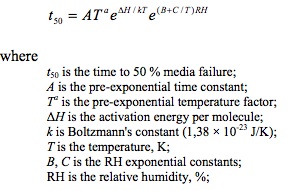
was derived from the laws of thermodynamics and, in this form, can readily be seen to handle easily the two critical stresses of temperature and RH. For the temperature range used in this test, it is common practice to set a and C to zero [5].
The Eyring model equation then reduces to give the time to 50 % of media failures as:

For each stress condition, an acceleration factor is computed and used to estimate the difference between the 50 % failure at the stress conditions and the usage conditions. These factors are then used to normalize the data to the usage condition.
A log mean and standard deviation are then computed and used, together with a confidence factor to estimate the life expectancy at ambient conditions.
3. Definitions
DVD-R:
Stands for Digital Versatile Disc – Recordable. A format of DVD which uses dye sublimation
recording technology, and conforms with ISO/IEC DIS 23912:2005 Information technology - 80
mm (1.46 Gbytes per side) and 120 mm (4.70 Gbytes per side) DVD Recordable Disk (DVD-R).
On DVD-R, data can be written to once and read many times.
DVD+R:
Stands for Digital Versatile Disc + Recordable. A format of a recordable DVD which uses dye
sublimation recording technology, and conforms with ISO/IEC 17344:2005: Information
technology -- Data interchange on 120 mm and 80 mm Optical Disk using +R format --
Capacity: 4.7 and 1.46 Gbytes per side. On DVD+R, data can be written to once and read many
times.
DVD-RW:
Stands for DVD-ReWritable. A format of a re-writable DVD disc, which uses phase change
recording technology, and conforms with ISO/IEC 17342:2004: Information technology -- 80
mm (1.46 Gbytes per side) and 120 mm (4.70 Gbytes per side) DVD re-recordable disk (DVD-
RW). On DVD-RW, data can be written to several hundred times and read many times.
DVD+RW:
Stands for DVD+ReWritable. A format of a re-writable DVD disc, which uses phase change
recording technology, and conforms with ISO/IEC 17341:2005: Information technology -- Data
interchange on 120 mm and 80 mm optical disk using +RW format -- Capacity: 4.70 Gbytes and
1.46 Gbytes per side. On DVD+RW, data can be written to several hundred times and read many
times.
CD-R:
Stands for Compact Disc – Recordable. An extension of the CD format allowing data to be
recorded once on a disc by using dye sublimation technology. Defined by part II of the Orange
Book standard. Orange Book is the set of specifications created by Philips and Sony to define the
optical signal characteristics, physical arrangement, writing methods and testing conditions for
CD-R (Orange Book Part II) and CD-RW (Orange Book Part III) discs.
Test Disc:
An individual disc as used in this aging study.
Group:
A collection of test discs that are aged under the same accelerated aging condition.
Stress:
A condition of elevated temperature and relative humidity used to accelerate the aging process
for optical media in this study.
ECC:
Stands for Error Correction Code, additional information added to data to allow errors to be
detected and possibly corrected.
BLER:
Stands for BLock Error Rate, a measure of the average number of raw channel errors when
reading or writing CD type media. BLER is a measure of the number of data blocks per second
that contain detectable errors at the input of the C1 decoder.
E32:
Stands for Error 32. In a CD system, there are two stages or levels of error correction codec.
Each stage of the codec can correct two bad symbols in a block. The first number in an "E" error
always references the number of errors and the second number always references the codec level.
For example, the error type E11 means one bad symbol was corrected in the first stage (C1) or
level 1; E21 means two bad symbols were corrected in the C1 stage; E31 means that there were
three or more bad symbols at the C1 stage. This block is uncorrectable at the C1 stage, and is
passed to the C2 stage. E12 means one bad symbol was corrected in the C2 stage and E22 means
two bad symbols were corrected in the C2 stage. E32 means that there were three or more bad
symbols in one block at the C2 stage. This error is not correctable.
PI and PO:
Stands for Parity Inner and Parity Outer. Reed-Solomon Product Code (RS-PC) is a method of
error correction employing a number (usually two) of groups of Reed-Solomon parity bytes
computed from rows, columns, or diagonals of a rectangular data array. DVD uses two-group
method of RS-PC for error correction. The redundant codes of rows and columns are called
Parity of the Inner code (PI) and of the Outer code (PO) respectively. DVD discs correct small
read errors using PI, that operates on rows, and corrects large read errors using PO, that operates
on columns of the data array.
PIE:
Stands for Parity Inner Error. The number of error corrections made on incoming rows of data in
the first pass of the decoder using the inner parity correction code. A row of an ECC Block that
has at least 1 byte in error constitutes a PI error. PIE is measured over 8 ECC blocks. In any 8
consecutive ECC Blocks the total number of PI errors before correction shall not exceed 280,
also called PI Sum 8.
POE:
Stands for Parity Outer Errors. Parity outer fails. The decoder was unable to correct the data
using the outer parity codes. It is measured over 1 ECC block.
Incubation Cycle:
A complete single incubation cycle includes the initial ramping to stress conditions, the
maintenance at that stress condition and ramping back to ambient conditions. This is described in
section 4 of this paper.
Life expectancy:
The length of time (usually measured in years) one can expect, with 95 % confidence, that a disc
is expected to store data before uncorrectable errors are imminent, when the disc is maintained at
the ambient conditions of 25 °C and 50 % relative humidity.
Shelf life:
The length of time, up to which, a blank disc is expected to be suitable for recording.
EOL:
Stands for End of Life. The state of the disc when the level of correctable errors is such that the
onset of uncorrectable errors is imminent. For CD type media, this means when BLER reaches
220 and for DVD type media, this means when PIE reaches 280. Also may be used to describe
the point at which uncorrectable errors actually occur.
4. Procedure
4.1 Procedural Overview:
A sampling of ninety recorded test discs was divided into six groups. Each group of discs was
exposed to one of six stresses, which are combinations of temperature and relative humidity as
described in section 4.3. After each period of incubation, each disc was measured for BLER (in
the case of CD type media) or inner parity (PI) errors (in the case of DVD type media). An
example of the testing and incubation timeline is given in Fig. 1. Data collected at each test point
for each individual disc was used to determine a time to failure (usually measured in hours) for
that disc. The times to failure for discs at each stress were fitted to a log-normal distribution to
determine a mean time to failure for that stress. The resulting six mean times to failure were
regressed against temperature and relative humidity according to an Eyring acceleration model.
This model was then used to estimate the distribution of lifetimes at a preferred usage condition.
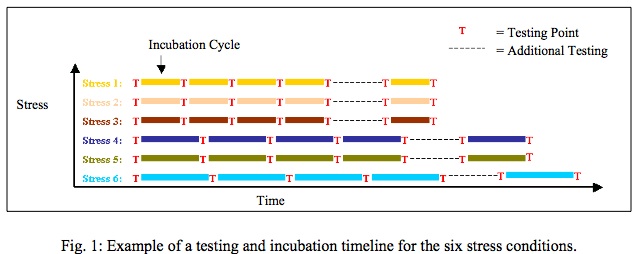
4.2 Test method:
In general, the process of accelerated aging requires that discs in each stress condition be ramped
from ambient conditions to that stress condition in an environmental chamber, maintained at that
stress condition for a particular period of time and then ramped back to ambient conditions. This
incubation cycle should occur a minimum of four times and possibly more during the course of
testing. The ramp duration and conditions must be chosen to allow sufficient equilibration of
absorbed moisture within the substrate. Large departures from equilibrium conditions can result
in the formation of liquid water droplets inside the substrate or at its interface with the recording
layer. Gradients in the water concentration through the thickness of the substrate must also be
limited. These gradients drive expansion gradients, which can cause significant disc curvature.
In order to minimize the effects of moisture concentration gradients in large chambers, the ramp profile outlined in Table 1[6] was used. The ramp durations specified ensure minimal stress in the test discs. A complete incubation cycle, including the ramp and aging stages, are portrayed graphically for one of the stress conditions in Fig. 2.


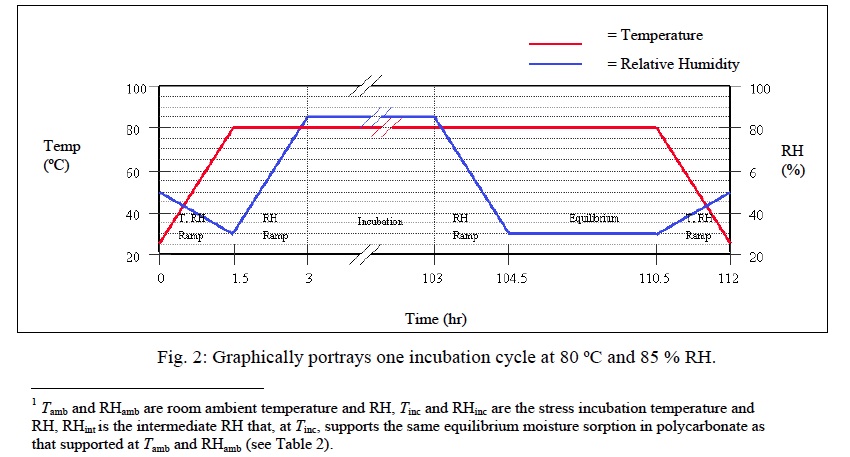
A system independent of the chamber control system was used to monitor the temperature and the relative humidity conditions in the test chamber during the stress test for independent verification of every chamber's conditions.
4.3 Test conditions:
The six stress conditions used in this study are shown in Fig. 3. Table 2 specifies the
temperatures, the relative humidity (RH), the initial incubation cycle durations, the minimum
number of incubation cycles and the sample distributions for each stress condition. If necessary,
more incubation cycles may be added or the duration of the incubation may be increased to
determine the time to failure of the media at any specific stress. A separate group of test discs is
used for each stress condition. This procedure constitutes a constant-stress test plan. All
temperature stress points have an allowed range ±2 ºC and all relative humidity stress points
have an allowed range of ±3 %RH.
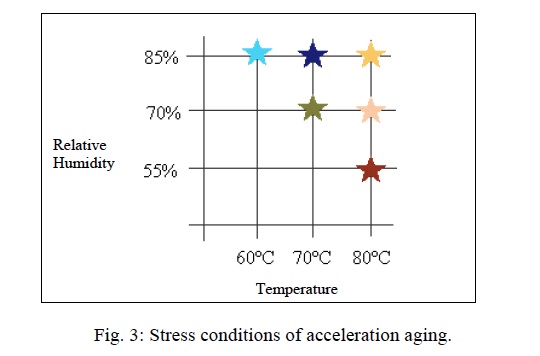

The intermediate RH (RHint) in Table 2 is calculated assuming a 25 ºC and 50 % RH ambient. If the ambient conditions are different, the intermediate RH to be used is calculated using the equation:

The stress conditions tabulated in Table 2 offer a sufficient combination of temperature and RH to satisfy the mathematical requirements of the Eyring model to demonstrate linearity of the natural logarithm (ln) of the maximum BLER (ln(BLERmax)) versus time in the case of CD type media, and ln(PI errorsmax) versus time in the case of DVD type media, and produce a satisfactory confidence level to make the desired conclusions.
4.4 Test discs:
Test discs for this study were selected to be nominally identical with regard to substrate groove
structure, layer structure, coating composition, recording capacity, and age prior to test initiation.
Media was chosen from different lots and production lines in order to be representative of
normal process variations. All discs were maintained within the manufacturer's shipping and at
ambient storage conditions prior to recording.
Each of the test discs were recorded disc-at-once with a single session recording. In other words, the disc was recorded such that the entire disc is written to in one pass without turning off the laser. All CD type discs in this study met the Yellow Book (Philips-Sony Compact Disc Read Only Memory System Description) specification (also described in the ISO/IEC 10149 or EMCA-130 standards). Likewise, all DVD type media in the study satisfied the DVD specification (described in ISO/IEC 16448:2002 or ECMA-267, third edition, April 2001 standards).
4.4.1 For CD-R discs:
Since the emergence of CD-R technology, a number of different dye types have been used as the
recording layer, including Cyanine, Phthalocyanine, and Metallized Azo, or their hybrids [7].
However, due to current conditions in the dye market, a single dye type has become the most
popular in CD-R media and is based on the Phthalocyanine dye. All CD-R discs in this study
used Phthalocyanine dye as the recording layer. Due to limitations with the CD analyzer, it was
not possible to include CD-RW type media in this study.
4.4.2 For recordable and rewritable DVD discs:
There are several different types of recordable DVD available, including DVD-R for general,
DVD-R for Authoring, DVD+R, DVD-RW, DVD+RW, DVD-RAM and more recently dual
layer DVD. In this study, we selected DVD-R for general, DVD-RW, DVD+R and DVD+RW.
4.5 Analyses of the discs:
Maximum BLER for CD-R
The maximum BLER number is the largest BLER (see earlier definition) measured anywhere on
a disc.
Maximum Inner Parity Errors for DVD
The Maximum PI errors number is the largest PIE (see earlier definition) measured anywhere on
a disc.
4.6 Measurements and collecting data:
This study uses the measured maximum BLER for recordable CD and the measured maximum
inner parity (PI) errors for recordable DVD as a high-level estimate of the quality of the media at
the time of measurement. The purpose of measuring BLER and PI errors is to establish a
practical estimation of a compatible system's ability to read the recorded data without
uncorrectable errors occurring.
However, the correlation between actual loss of information and the measured maximum BLER and PIE actually depends on several factors including the playback system as well as the media quality. A BLER of 220 and the PI errors of 280 are conservative levels chosen by the recordable CD and DVD specifications as a predictor of the onset of uncorrectable errors and thereby end of life.
4.6.1 Media recording and initial data:
There are many formats and speeds of discs (for example, 4X, 8X, 16X…) in the market and yet
there is no unified standard for the drive write strategy. Therefore each recorder drive
manufacturer develops their own drive to satisfy the write/read requirements of recordable CD
and DVD discs. As such, there is no guarantee that the recorder used to burn a disc is fully
compatible with that disc. This can, and often does, lead to very high error rates immediately
after recording the disc, which in turn can make aging analysis very difficult. It is therefore
important to ensure that initial error rates are low by ensuring that the recording drive and the
media are as compatible as possible [8,9].
To ensure recorder drive and media compatibility, four Disc Burning Stations (DBS) were built in the NIST laboratory with new recorder drives. Each drive used the latest version of its firmware to ensure its best performance.
To determine the recorder with the highest level of compatibility with each brand of media, a limited number of recordings were made for each brand by each recorder in the four DBS. The discs were then burned by the most compatible recorder and initial error rates monitored to ensure that the recorder continued to operate correctly.
Where possible, only media with an initial BLER (in the case of CD type media) below 40 and with PIE (in the case of DVD) below 100 were included.
4.6.2 Disc Burning Stations:
In an effort to ensure the integrity of the results, all disc burning station (DBS) computer
configurations were the same. For this study, each disc burning station (DBS) consisted of a
Pentium-4 processor workstation with the following specifications:
Intel Pentium-4 Processor 3.6 GHz w/ 800mhz FSB,
1GB DDR2-533 MHz dual channel RAM,
Seagate 120 GB 7200 rpm SATA hard drive w/ 8 MB cache,
Microsoft Windows XP Pro w/ doc and media.
All discs were indexed to associate each with the particular DBS and DVD recorder drive used to record it. The recording drives used in this study include the Sony DRU-510A, 700A, 800A, Pioneer DVR-A09, Plextor PX-716SA and NEC ND-2510A. The drive chosen for the particular brand of media was the drive shown to be most compatible with that media.
Each DBS was equipped with Roxio Easy Media Creator 7, version 7.5.0.47 ENU. The same image was recorded on DVD media at the most compatible speed. The same image was recorded on all CD media also at the most compatible speed.
4.6.3 Analyzer:
In order to monitor the change in the error rate during the aging, the discs were analyzed after
each incubation cycle using optical disc analyzers. A CD analyzer capable of reading BLER (in
the case of CD) and a DVD analyzer capable of reading PI error (in the case of DVD) were used.
For testing CD: CD CATS SA3 Advanced can measure all relevant parameters of CD discs. All measurements were performed according to optical disc industry standards. All relevant parameters including correctable BLER (including E11, E12, E21, and E22), uncorrectable E32 errors, jitter, asymmetry and more were measured using this system. Unfortunately, this system is not capable of testing CD-RW type media, which is why CD-RW media was not included in this study.
For testing DVD: CATS SA300 DVD-R/RW PRO and CATS DVD+R/RW PRO from Audio Development were used to analyze the DVD media in this study. These systems measure recorded and unrecorded DVD discs and include the Pulstec SDP-1000 optical drive. All relevant parameters including inner parity error (PIE), outer parity error (POE), jitter, asymmetry and more were measured using this system.
All media testers were regularly calibrated to ensure the integrity of the results.
4.6.4 Collecting data
Test discs were not analyzed in their entirety but analyzed at five test bands throughout the
diameter of the test disc. DVD test points are located at the following radii (in millimeters):
24.00 to 25.20, 31.95 to 33.15, 39.90 to 41.10, 47.85 to 49.05, and 55.8 to 57.00, from the inside
to the outside of the disc. CD-R test points are at the following times (in minutes:seconds):
00:00 to 03:00, 19:00 to 22:00, 38:00 to 41:00, 57:00 to 60:00, 76:00 to 79:00.
The same tester was used for any particular test disc through out the study and each disc was indexed to indicate which analyzer/tester was used to analyze that disc.
4.7 Requirements of incubation condition:
The temperature and relative humidity levels used in this study were chosen to ensure that there
was no change of phase of the moisture within the environmental chamber over the test
temperature range, and such that no condensation occurred at cooler areas of the chamber such as
the observation windows, cable ports, wiper handles, and so on. Any droplets caused by such
condensation could damage the media and/or influence the error rates. Furthermore, the
temperature of the testing environment must not be so high so as to cause any plastic
deformation within the disc structure. Practical experience shows that 80 ºC and 85 % RH is the
upper limit for control within most accelerated test cells. Table 2 shows the complete stress
conditions used in this study. Disc samples were uncovered and placed vertically within the
chamber. Discs were aligned so that their surfaces were parallel to the chamber airflow. A space
of at least 2 mm was maintained between discs.
4.7.1 Environmental Chambers:
A Parameter Generation and Control Inc (model: 9131-3119) 30 cubic feet environmental
chamber was used to control precisely the temperature and relative humidity through various
combination settings of temperatures (5 C to 85 C) and relative humidity (10 % to 95 %). The
controlled accuracy is ± 0.2 C for temperature and ±0.5 % for relative humidity.
4.8 Incubation time requirements:
Since there were six stress conditions to be implemented, the media from each brand were split
into six groups (see Table 2). The first incubation cycle testing was completed in the timeline
shown in Fig. 4, and subsequent cycles followed a similar format but with modified incubation
durations. The most severe stress (80 ºC, 85 %) was conducted first and tested after incubation to
determine if the incubation durations should be increased for subsequent cycles and to what
extent. Increasing the incubation durations for subsequent cycles did not increase the total
duration of the study since the limiting factor is the number of analyzers available to test the
large numbers of media. There were two analyzers available for testing DVD media and one
available for testing CD media.
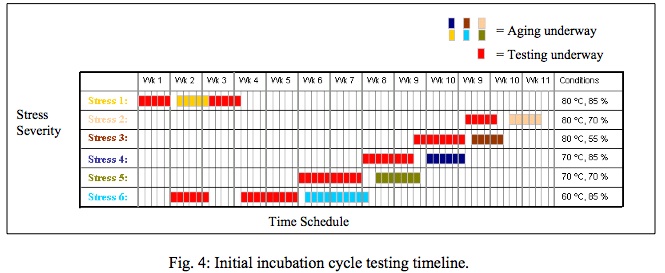
4.9 Step-by-step summary of the analysis for calculation of media life:
The following is a brief outline of the steps used to estimate the life expectancy of information
stored on recordable optical media as a function of temperature and relative humidity.
1) Determine the failure time for each test disc.
2) Determine the critical value of the median rank of each test disc, and plot the critical value of
the median rank versus failure time on a log-normal graph.
3) Verify that the plots for all stresses are reasonably parallel to one another. The log standard
deviation for each stress may be calculated using standard techniques or estimated from
straight lines drawn through the plots. Calculate the log mean and standard deviation for each
stress.
4) Regress the log mean, temperature, and relative humidity for all stresses using the reduced
Eyring equation. Calculate the estimated log mean for the standardized temperature and
relative humidity (25 ºC and 50 % RH).
5) Determine the acceleration factor for each stress.
6) Normalize all the failure times by multiplying each failure time by the acceleration factor for
its stress. Combine all normalized failure times and censored data into one data set. For this
entire set, make one composite log-normal plot. Estimate the log mean and the log standard
deviation at the usage conditions from the combined data.
7) Calculate 95 % survival probability with 95 % confidence.
5 Results
This study was performed on optical media purchased in 2005. At the time of the study, the
quality of optical media varied significantly and the quality has changed with newer
versions and products. Therefore, the results of this study should only be considered a
snapshot of the longevity of the optical media at the time of purchase.
Life Expectancy: For this study, the estimated life expectancy is defined as the length of time one can expect, with 95 % confidence, that the product will survive before the onset of uncorrectable errors are imminent, when stored at the ambient conditions of 25 °C and 50 % relative humidity.
In CD type media, the onset of uncorrectable errors is considered imminent when the correctable error rate (BLER) reaches 220. In DVD type media, the onset of uncorrectable errors is considered imminent when the correctable error rate (PIE) reaches 280.
Recordable CD: There were seven CD-R media products tested in this study. Ninety sample discs were tested for each product. Equipment to test CD-RW media was not available for this study. Fig. 5 shows the results for these CD-R media. Five of the seven CD-R products had estimated life expectancies in ambient conditions of more than 45 years. The remaining two products had estimated life expectancies in ambient conditions of 30-45 years.

Recordable and rewritable DVD: There were fifteen DVD products tested, including five DVD-R, five DVD+R, two DVD-RW and three DVD+RW types. There were ninety samples tested for each product. Fig. 6 shows the results for DVD media. Overall, seven of the products tested had estimated life expectancies in ambient conditions of more than 45 years. Four products had estimated life expectancies of 30-45 years in ambient storage conditions. Two products had a estimated life expectancy of 15-30 years and two products had estimated life expectancies of less than 15 years when stored in ambient conditions.

Fig. 7 shows the recordable DVD life expectancies (95 % survival rate) by type given as a percentage of the total number of samples of that type.

To determine a specific standardized lifetime expectancy for the longer lasting media would have required several more aging iterations. Unfortunately, this was not possible during this study but is recommended as a follow on to this study.
The step by step example of the analysis is given in Appendix I and describes the mathematical and statistical process used to determine the life expectancy of the media. The final result will show the 95 % survival time with 95 % confidence, at ambient conditions of 25 °C and 50 % relative humidity.
6 Conclusions
We have implemented an artificial aging study for estimating the life expectancy of many of the
popular products available in the market place (as of 2005). The study was based on the Eyring
model. For media tested in this study, there was a significant variation in the longevities among
the DVD products, although most life expectancies were greater than 30 years. It should be noted
that DVD media technology was evolving (e.g.: recording speed) quickly at the time these
products were on the market. All CD media in this study had life expectancies of greater than 30
years.
CD/DVD stability divide: It has been speculated that the archival quality of CD is superior to that of DVD. The basis for this lay with the physical differences in CD and DVD optical media and the maturity of the technology. In particular, the size of the bit markings in CD media not only reduces the relative effect of media or dye degradation, but also means that more stable, less sensitive dye may be used. In our testing and analysis, a greater percentage of CD products achieve a long life expectancy relative to the DVD products. It is not clear if the physical and chemical differences between these two technologies will prohibit DVD from being as stable as CD or if any difference in stability will be reduced as DVD technology and manufacturing processes become more mature.
No obvious or significant difference in the longevity of differing DVD types emerged in this study. All CD media in this study used Pthalocycaine as the recording layer and the results here may not reflect the longevities of CD-R type media with other types of recording layers.
Many factors affect the longevity of optical media, including the stability of the materials used in the recording and substrate layers; the relative sensitivity of the recording layer to the effects of heat, humidity and light; the quality of the manufacturing process; the amount and type of markings or labels attached; the compatibility of the media with the recording device and the quality of the initial recording; the age of the media at the time of recording; the storage and handling conditions encountered and more. All these factors are important in determining the actual life of a particular disc and there are obviously great variations possible within each factor. It is not feasible to model all of the factors and this study does not attempt to. This study limited the modeling to the effects of temperature and relative humidity in order to extrapolate to the ambient storage conditions of conditions of 25 °C and 50 % relative humidity. For more information on many of these factors and as a guide to the care and handling of CDs and DVDs, the following resource is available from CLIR and NIST [11].
The results show that high quality optical media with good quality initial recordings can survive several decades in ambient storage conditions.
For future work, it is recommended that new products continue to be tested, especially after the technology further matures and stabilizes. An ongoing process of regularly testing newer CD and DVD products is recommended for the Library of Congress. Future studies should include longevity testing and separate, but complementary read/write compatibility testing. The results of compatibility testing will help researchers ensure that all media identified for longevity testing is recorded optimally.
This type of accelerated aging technique may best be used as a way to compare the quality of products [12]. Therefore, it is recommended that a media quality test be developed such that the test discs can be compared to an archival quality test disc. The compatibility and longevity of the test disc would need to be known.
7 Normative References
ISO 18927:2002 Imaging materials – Recordable compact disc systems – Method for
estimating the life expectancy based on the effects of temperature and relative humidity,
first edition
ECMA-379, 2007 Test Method for Estimation of the Archival Lifetime of Optical Media
IEC 60908 (1999-02): Compact disc digital audio system. This document including
amendments approximates the Philips-Sony Red Book
ISO/IEC 10149:1995, Read-Only 120 mm Optical Data Disks (CD-ROM)
EMCA130 2nd Edition - June 1996 Data interchange on read-only120 mm optical data
disks(CD-ROM)
Orange Book, part B, -- Recordable Compact Disc System, November 1990 (SONY and
Philips Corp.)
ISO/IEC 16448:2002 Information technology -- 120 mm DVD -- Read-only disk
ISO/IEC DIS 23912:2005 Information technology - 80 mm (1.46 Gbytes per side) and
120 mm (4.70 Gbytes per side) DVD Recordable Disk (DVD-R)
ISO/IEC 17344:2005: Information technology -- Data interchange on 120 mm and 80
mm Optical Disk using +R format -- Capacity: 4.7 and 1.46 Gbytes per side
ISO/IEC 17342:2004: Information technology -- 80 mm (1,46 Gbytes per side) and 120
mm (4,70 Gbytes per side) DVD re-recordable disk (DVD-RW)
ISO/IEC 17341:2005: Information technology -- Data interchange on 120 mm and 80
mm optical disk using +RW format -- Capacity: 4,7 Gbytes and 1,46 Gbytes per side
ECMA-267, 2001, 120 mm DVD - Read-Only Disk, 3rd edition
ECMA-337, DVD+RW - Rewritable Optical Disks, 4.7 GB
ECMA-338, DVD-RW - Rewritable Optical Disks, 4.7 GB
IEEE 101-1995, Guide for the statistical analysis of thermal life test data
Hamada, E, et al, Recording process of recordable compact disc, Optical Data Storage,
D. B. Carlin and D. B. Kay, eds., Proc. SPIE 1663, 443–446, 1992.
Yokota, C, et al, Phthalocyanine CD-R for high-speed recording, Optical Data Storage,
G. R. Knight, H. Ooki, and Y. Tyan, eds., SPIE Proc. 2514, 249–257, 1995.
Bennett, H.,Understanding CD-R and CD-RW, Optical Storage Technology
Association, California, USA, 2003.
Murray, W.P., Accelerated service life predictions of compact disks, ASTM STP 1202,
p.263-271. American Society for Testing and Materials, 1994
Tobias, P.A. and Trindade, D.C., Applied Reliability. New York: Van Nostrand
Reinhold, 1986 (2nd ed. 1995).
Wrobel, J.J., Ramp profiles for optical disc incubation, SPIE vol. 2338, optical data
storage, p. 191-202, 1994.
Slattery, O.T. et al, Stability Comparison of Recordable Optical Discs—A Study of
Error Rates in Harsh Conditions, Journal of Research of the National Institute of
Standards and Technology, Vol. 109, Number 5, September-October 2004.
Slattery, O.T., DVD-ROM Drive Compatibility Test for DVD-R(General), DVD-RW,
DVD+R, DVD+RW and DVD-RAM Discs (Phase1), NIST Special Pub 500-254, 2003
Slattery, O.T., DVD Drive Compatibility Test for DVD-R (General) and DVD+R Discs,
including DVD Creation Plan (Phase2), NIST Special Publication 500-258, 2004
Experimental Statistics, National Bureau of Standards Handbook 91. Washington, DC,
US: National Institute of Science and Technology, 1963.
Byers, F. Care and Handling of CDs and DVDs: A Guide for Librarians and
Archivists, National Institute of Standards and Technology and the Council on Library
and Information Resources, 2003.
Porck, H., The Predictive Value of Artificial Aging Tests, European Commission on
Preservation and Access, Amsterdam, 2000.
APPENDIX I
The following are the step by step results and analysis for an example recordable DVD media.
Step 1: For each stress condition, the time to failure is determined for each sample. The failure time (in hours) of each test disc is calculated from the slope and intercept of the regression as the time at which the test disc would have a max PISum8 of 280.
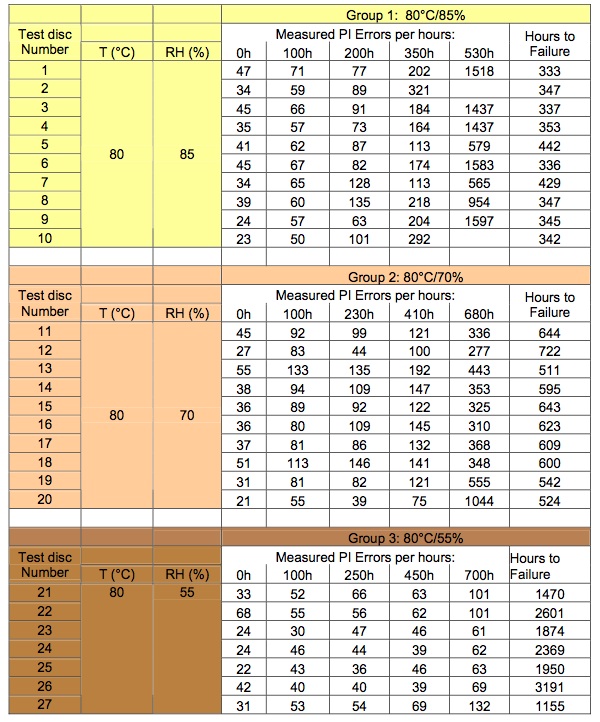


Step 2: For each stress condition, the failure order, median rank and critical value within their respective stress conditions are determined and the specimens are ordered by increasing times to failure. The median rank is calculated using the estimate (i-0.5)/n, where i is the failure order and n is the total number of test discs in that stress condition. The log mean and the standard deviation of the times to failure are calculated.


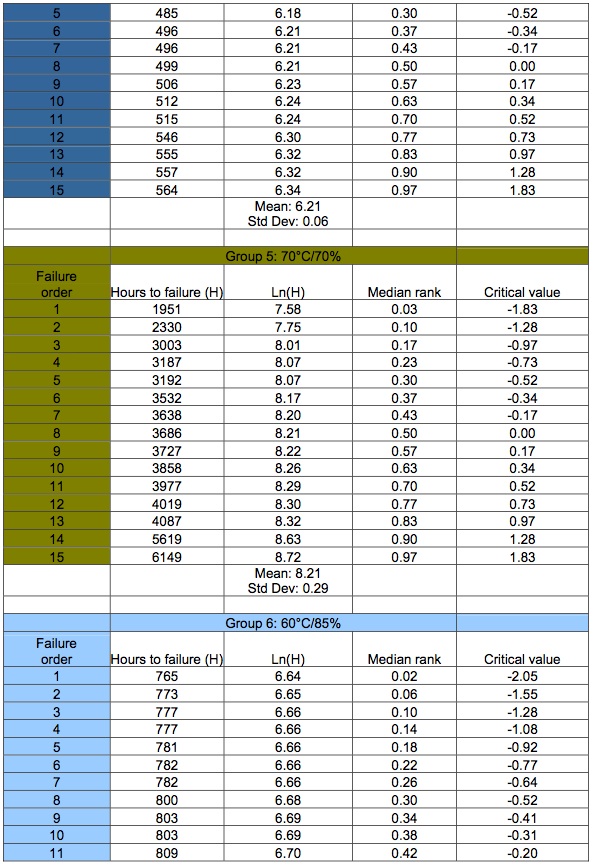

Step 3: Best fit lines are drawn through the data. If the lines are judged to be sufficiently parallel, the assumption of equivalent log standard deviation among the individual data sets is verified.
In figure AI.1, the median rank (multiplied by 100) is plotted against hours to failure for each stress
condition and best fit straight lines are drawn through the plotted data.
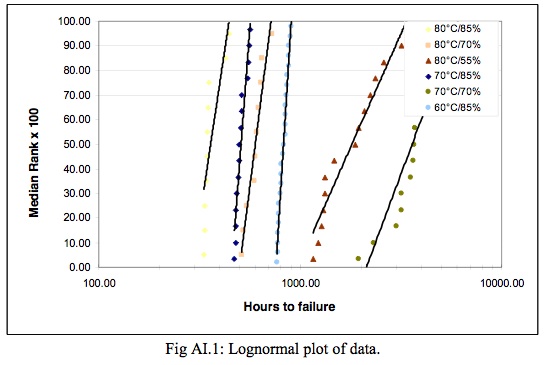

Step 4: The log mean values are now used, along with the temperature and relative humidity, to determine the reduced Eyring equations constants (A, B and ΔH/k) by fitting to the reduced Eyring equation.

In practice, the regression is done using the equation that results from taking the logarithm of both sides of the reduced equation:

Fitting to the reduced Eyring equations gives the following values for B, ΔH/k and ln(A) :

The calculated ambient life time can then be calculated as follows:

Step 5: For each stress condition, an acceleration factor is calculated. The acceleration factor is the calculated life time for the ambient condition divided by the calculated life time for the stress condition.

The following example shows the calculation for the stress condition at 80 °C/85 %:

Steps 6: The failure times of all test discs at all stress conditions are normalized to the usage condition using the acceleration factor for each stress condition and ordered according to the normalized times to failure. The mean and standard deviation is calculated for all the discs.
The median rank for each test disc is estimated as before in step 2 using the estimate (i-0.5)/n, where i is the normalized failure order and n is the total number of test discs.

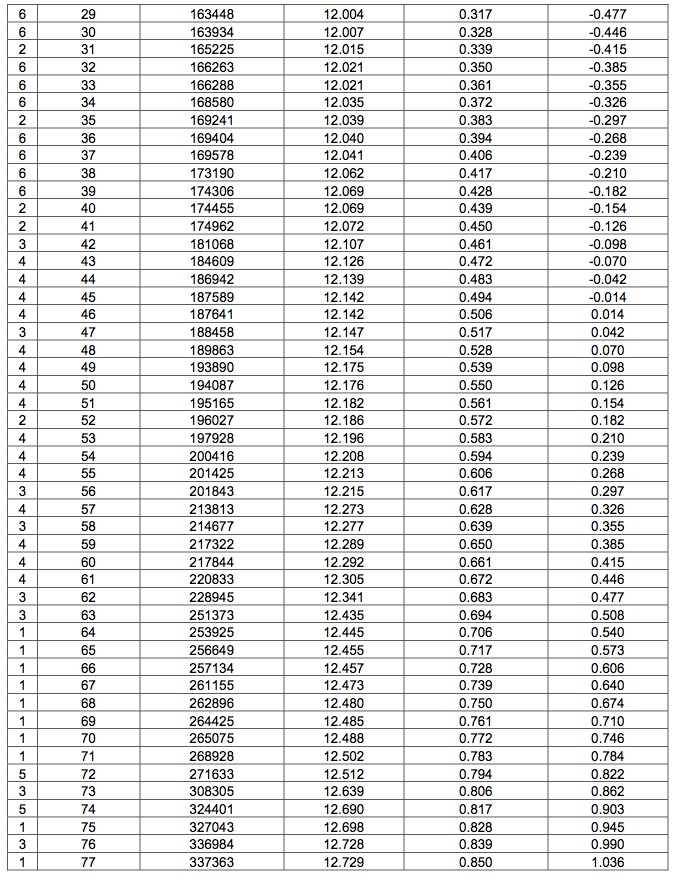

Table AI.7: Group number, overall failure order, hours to failure, log of hours to failure, median rank, critical value and the log mean and standard deviation of the normalized data.
From the data, the log mean, μ, is 12.28 and the log standard deviation, σ, is 0.45. Therefore, the estimated t50 at ambient conditions (25 C / 50 % RH) is t 50 e12.28 2.16 10 5 hours or about 24.7 years, in broad agreement with that calculated in step 4. This is the estimate of the time until 50 % of the product will fail.
The normalized failure times can be plotted as a composite graph.

We then estimate the 95 % survival probability with 95 % confidence to be 9.33 10 4 hours or about 10.7 years.
Using this model, the life expectancy is calculated for discs maintained at 25 °C/50 % RH. Discs exposed to more severe conditions of temperature and humidity are expected to experience a shorter life.
APPENDIX II
Disc code system for the Life Expectancy test
Jian Zheng @ July 26, 2004

WHERE
A C, A, B, D, or E stands for CD-R, DVD-R, DVD+R, DVD-RW or DVD+RW
discs respectively.
BB Brand of the media as below Table
nnn Series number
Gg g is the group number of the test disc
Xmm mm is the burning speed
C the symbol of the burner, as shown in table below
s the number of the Disc Burning Station (DBS).
T the number of the tester. Tester 1 is AudioDev’s SA3 CD CATS MLH2100 for
CD; Tester 2 is AudioDev’s SA300 DVD CATS Pro DPEP 1486 for
DVD+R/RW; and Tester 3 is the DPER 1534 for DVD-R/RW.
[Note] read out the disc information with Roxio DVDInfo Pro version 4.08 embedded in Roxio
Easy Media Creator 7.5.
All CD-R discs use Short Strategy for burning, meaning all discs use Phthalocyanine dye.
Note: These codes do not appear in this report, as they reveal proprietary information about the brand of the media and the burners used to write the data to the discs. This information is included for the benefit of other researchers who may wish to adopt a similar naming system for use in their own studies.
